Peer Reviewed Articles on Dating in the Digital Age
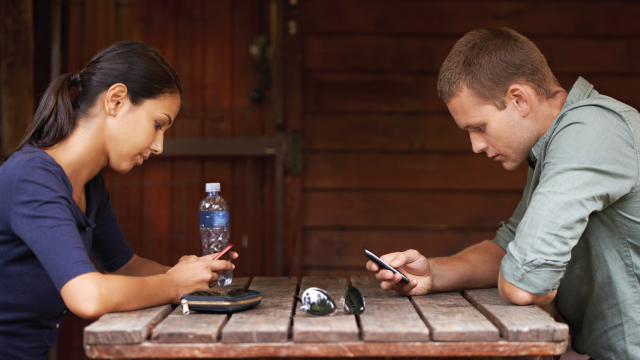
Pew Enquiry Center has long studied the changing nature of romantic relationships every bit well equally the office of digital technology in people's lives. This detail report focuses on the patterns, experiences and attitudes related to digital applied science use in romantic relationships. These findings are based on a survey conducted October. 16 to 28, 2019, among 4,860 U.S. adults. This includes those who took function as members of Pew Research Center'due south American Trends Panel (ATP), an online survey panel that is recruited through national, random sampling of residential addresses, equally well every bit respondents from the Ipsos KnowledgePanel who indicated that they identify equally lesbian, gay or bisexual (LGB). The margin of sampling mistake for the full sample is plus or minus two.1 percentage points.
Recruiting ATP panelists by phone or post ensures that most all U.S. adults have a take a chance of option. This gives us conviction that any sample can correspond the whole U.Due south. adult population (run across our Methods 101 explainer on random sampling). To further ensure that each ATP survey reflects a counterbalanced cross-section of the nation, the data is weighted to match the U.S. adult population past gender, race, ethnicity, partisan affiliation, education and other categories.
For more, come across the report'southward Methodology. You lot can also find the questions asked, and the answers the public provided in the topline.
Amidst growing debates about the impact of smartphones and social media on romantic relationships, a Pew Inquiry Center survey conducted in October 2019 finds that many Americans encounter some tech-related struggles with their significant others.
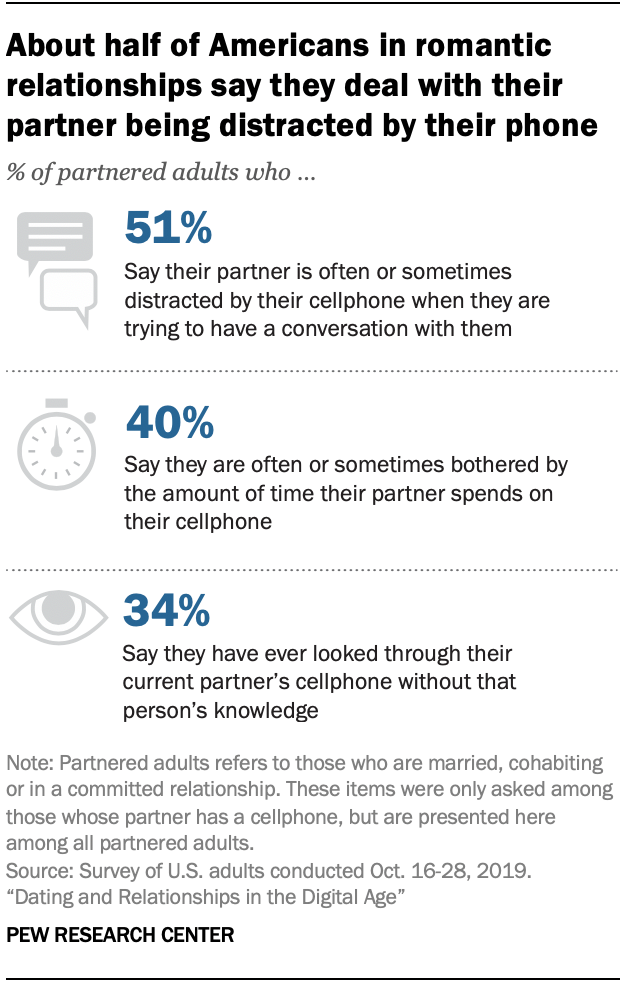 For instance, among partnered adults in the U.S. – that is, those who are married, cohabiting or in a committed relationship, roughly half (51%) say their partner is often or sometimes distracted by their cellphone while they are trying to have a chat with them, and four-in-ten say they are at least sometimes bothered by the amount of time their partner spends on their mobile device.
For instance, among partnered adults in the U.S. – that is, those who are married, cohabiting or in a committed relationship, roughly half (51%) say their partner is often or sometimes distracted by their cellphone while they are trying to have a chat with them, and four-in-ten say they are at least sometimes bothered by the amount of time their partner spends on their mobile device.
Partnered adults under the age of l are particularly likely to express the feeling that their partner is distracted by their telephone, with those ages 30 to 49 near likely to report this. Fully 62% of 30- to 49-year-olds and 52% of 18-to 29-year-olds who are in a romantic relationship say their partner is at least sometimes distracted by their phone when they're trying to talk them. Yet, this issue is not bars to younger age groups: 41% of partnered Americans ages 50 and older say they accept encountered this in their relationship at least sometimes.
With phones being such a distraction, people might exist tempted to expect through their partner's telephone. However, at that place is widespread agreement among the public that digital snooping in couples is unacceptable. Seven-in-ten Americans – regardless of whether they are in a relationship – say it is rarely or never acceptable for someone to look through their partner's cellphone without that person's noesis. All the same, 34% of partnered adults say they take looked through their partner's cellphone without that person'due south cognition, with women being more probable than men to say they have washed this (42% vs. 25%).
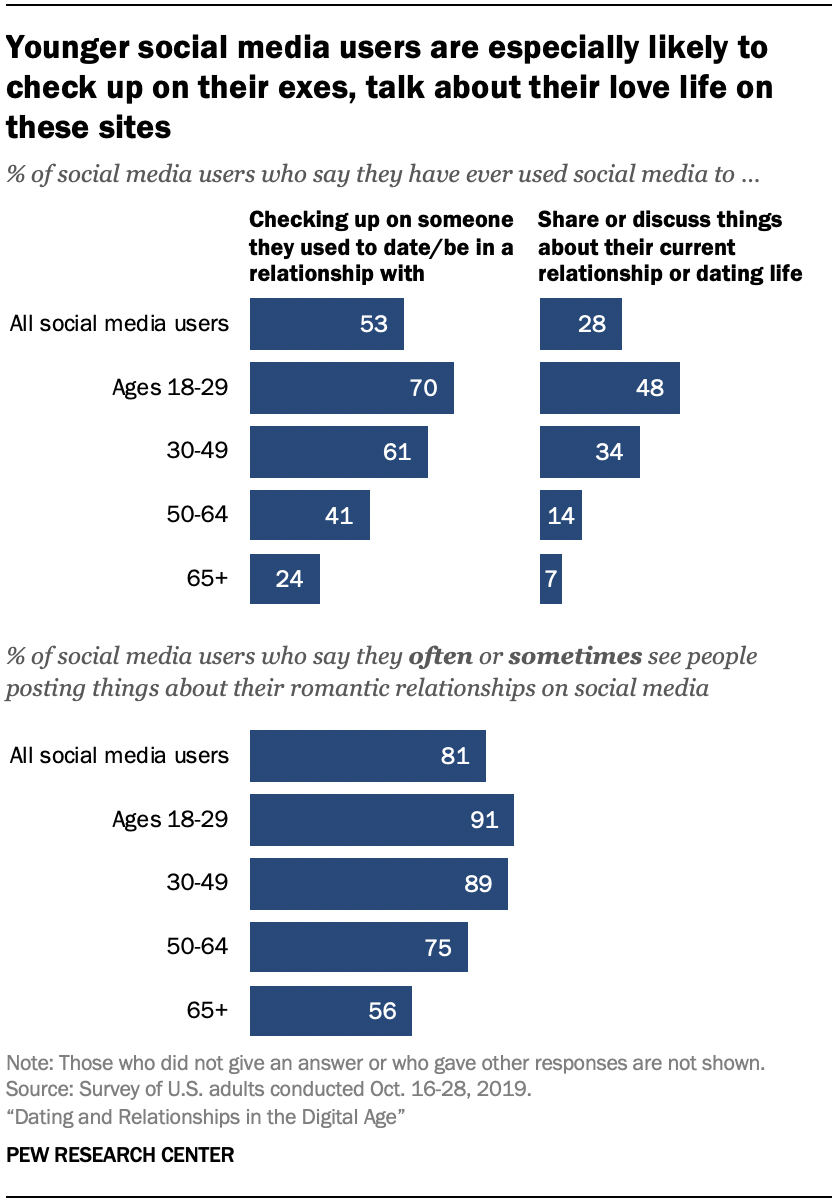 For many adults, social media plays a function in the mode they navigate and share information well-nigh their romantic relationships. Roughly eight-in-ten social media users (81%) report that they at least sometimes see others posting almost their relationships, including 46% who say this happens often, merely few say that seeing these posts affects how they feel nearly their own beloved life.
For many adults, social media plays a function in the mode they navigate and share information well-nigh their romantic relationships. Roughly eight-in-ten social media users (81%) report that they at least sometimes see others posting almost their relationships, including 46% who say this happens often, merely few say that seeing these posts affects how they feel nearly their own beloved life.
Moreover, social media has become a place where some users discuss relationships and investigate old ones. Roughly half of social media users (53%) say they have used these platforms to cheque upwards on someone they used to appointment or exist in a relationship with, while 28% say they take used social media to share or talk over things nearly their human relationship or dating life. For adult users under the age of 30, those shares who have used social media to checked-upward on a former partner (70%) or posted virtually their own honey life (48%) are fifty-fifty higher.
But social media can likewise be a source of annoyance and conflict for some couples. Amidst those whose partner uses social media, 23% say they have felt jealous or unsure of their relationship because of the way their electric current partner interacts with others on these sites, and this share rises to 34% amongst those ages 18 to 29.
Even so, some users view these platforms every bit an important venue for showing love and affection. This is especially true for younger users who are partnered: 48% of 18- to 29-twelvemonth-old social media users say social media is very or somewhat of import for them in showing how much they intendance about their partner.
These are some of the main findings from a nationally representative survey of 4,860 U.S. adults conducted online Oct. 16 to 28, 2019, using Pew Enquiry Heart'due south American Trend Panel.
Terminology
Several terms are used in this study to describe people's current relationship status. This reference guide explains each term.
Single is used to describe people who are not currently in a committed relationship merely may exist casually dating (31% of the sample).
Single and looking refers to people who are not in a committed human relationship (but may exist casually dating) and are looking for dates or a human relationship (15% of the sample).
Casually dating refers to unmarried people who are casually dating someone but are non in a committed relationship (4% of the sample).
Partnered refers to adults who are married, cohabiting or in a committed relationship (69% of the sample).
Cohabiting is used to describe people who currently live with their partner but are non married (11% of the sample).
Committed relationship is used to describe people who are in a relationship but are not married or cohabiting (viii% of the sample).
Single is used to refer to whatsoever adults who are not currently married – single, cohabiting or in a committed relationship (fifty% of the sample). This term is sometimes used in conjunction with the term "partnered" to refer to those who are cohabiting or in a committed human relationship (for example, unmarried partnered adults institute xix% of the sample).
40% of partnered adults say they are bothered by the amount of time their partner spends on their cellphone
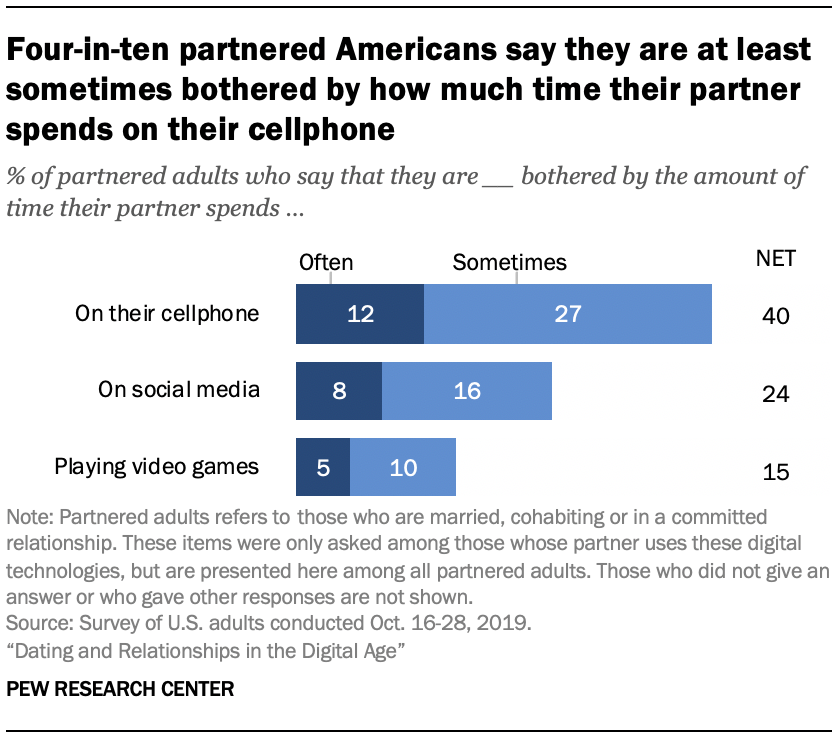 At the time of the survey, four-in-ten Americans who are married, living with a partner or who are in a committed human relationship say they are often or sometimes bothered by the amount of time their partner spends on their cellphone, including 12% who say they feel this way often.1
At the time of the survey, four-in-ten Americans who are married, living with a partner or who are in a committed human relationship say they are often or sometimes bothered by the amount of time their partner spends on their cellphone, including 12% who say they feel this way often.1
In addition, 24% of partnered Americans written report that they are at least sometimes bothered past the amount of time their partner spends on social media, while a somewhat smaller share (xv%) say they feel this way nigh their partner playing video games.
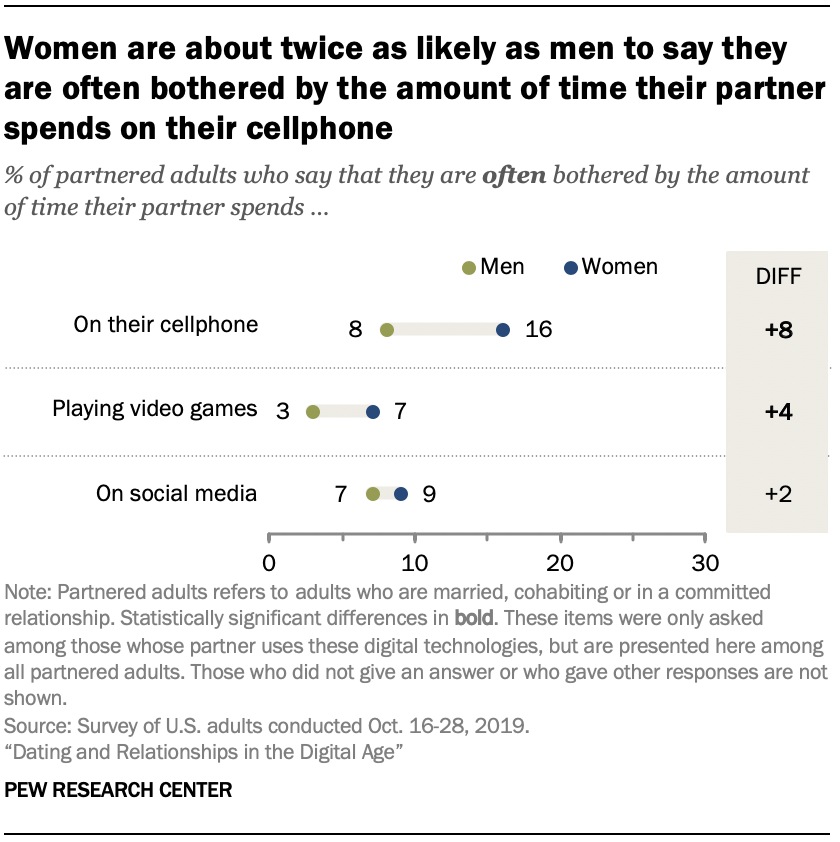 There are sure groups who are more likely to express annoyance over their partner'southward digital activities than others. Among partnered adults, women are more likely than men to say they are often bothered by the corporeality of fourth dimension their partner spends on their cellphone (sixteen% vs. 8%) or playing video games (7% vs. three%).two
There are sure groups who are more likely to express annoyance over their partner'southward digital activities than others. Among partnered adults, women are more likely than men to say they are often bothered by the corporeality of fourth dimension their partner spends on their cellphone (sixteen% vs. 8%) or playing video games (7% vs. three%).two
Beyond gender differences, people's attitudes too vary by historic period. Some 18% of partnered adults ages 18 to 49 say they are oftentimes bothered past the amount of time their partner spends on their telephone, compared with half dozen% of those ages l and older. Younger adults in romantic relationships also are more likely than their older counterparts to say they are often bothered by the amount of time their partner spends on social media (xi% vs. 4%) and playing video games (7% vs. 3%).
Roughly half of partnered people say their significant other is distracted by their phone at least sometimes when they endeavor to talk to them
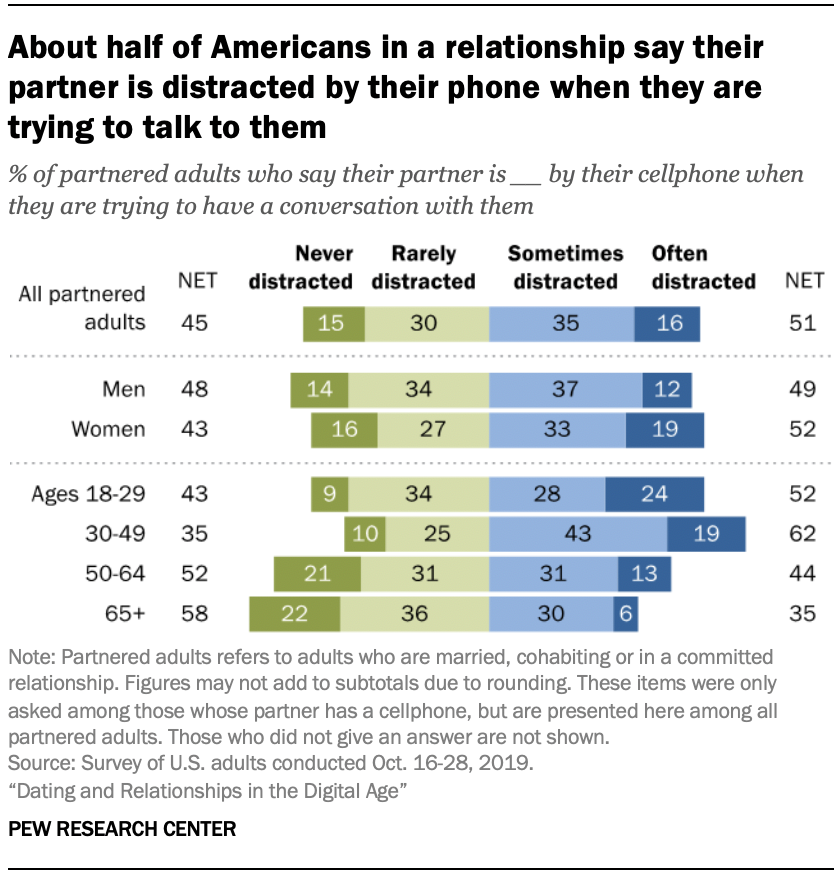 While relatively few Americans are familiar with the term "phubbing" – which is the do of snubbing others in favor of their cellphones – notable shares say they accept encountered that beliefs in their romantic relationships.
While relatively few Americans are familiar with the term "phubbing" – which is the do of snubbing others in favor of their cellphones – notable shares say they accept encountered that beliefs in their romantic relationships.
When asked to reflect on their partner'south cellphone apply, 51% of Americans in a romantic relationship say their partner is at least sometimes distracted by their cellphone when they are trying to take a conversation with them, including xvi% who say their significant other is often distracted by their mobile device.
This pattern differs by historic period: Roughly six-in-ten partnered adults ages thirty to 49 say their significant other is at least sometimes distracted by their cellphone when they are trying to concur a chat with them, compared with 52% of those ages xviii to 29 and fifty-fifty smaller shares for those ages 50 and older (41%). Among those in relationships, younger adults too are more likely than older adults to assert that their partner is oft distracted by their phone when they are trying to have a discussion (20% vs. 10%).
Women who are in a relationship are more probable than men to say their partner is ofttimes distracted by their phone while they are trying to agree a conversation, only this gender difference is well-nigh pronounced amongst younger adults. Three-in-ten partnered women ages 18 to 29 say their significant other is often distracted by their telephone while they are trying to concord a conversation, compared with 15% of men in this age grouping who say this.
About one-in-three partnered adults say they accept looked through their current spouse or partner's phone without their noesis, but there's strong public consensus this is unacceptable
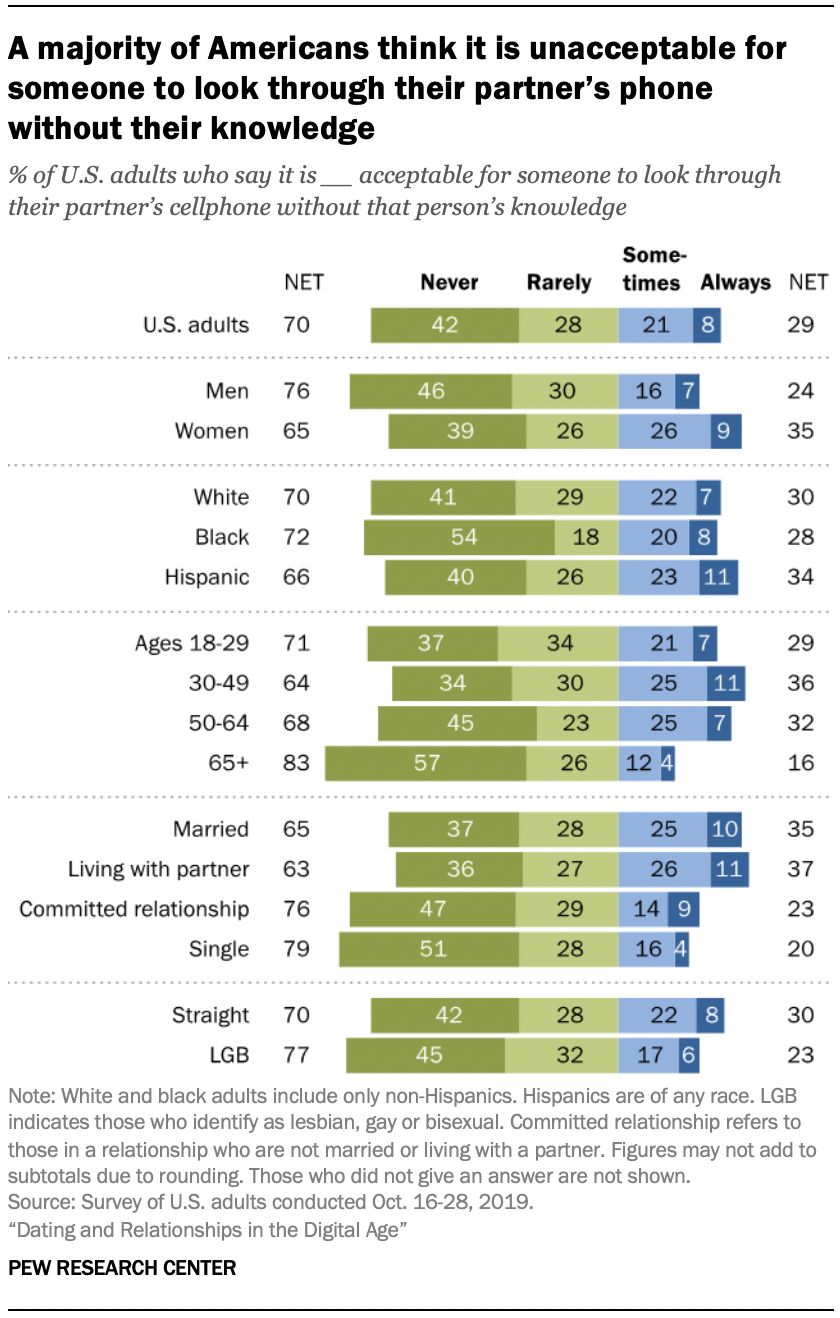 Americans – regardless of whether they are in a relationship – were asked in the survey about their views about some bug related to technology and relationships. For example, they weighed in on the acceptability of looking through a meaning other'south phone without that person'south cognition. 7-in-ten U.S. adults say information technology is rarely (28%) or never (42%) acceptable to await through a meaning other's cellphone without their knowledge. Smaller shares – well-nigh three-in-x (29%) – view this behavior every bit at least sometimes acceptable.
Americans – regardless of whether they are in a relationship – were asked in the survey about their views about some bug related to technology and relationships. For example, they weighed in on the acceptability of looking through a meaning other'south phone without that person'south cognition. 7-in-ten U.S. adults say information technology is rarely (28%) or never (42%) acceptable to await through a meaning other's cellphone without their knowledge. Smaller shares – well-nigh three-in-x (29%) – view this behavior every bit at least sometimes acceptable.
Majorities beyond major demographic groups view these actions every bit unacceptable, but there are some Americans who are more accepting of this behavior than others.
Women are more than likely than men to call back information technology is at least sometimes acceptable for someone to look through their partner's cellphone without their knowledge (35% vs. 24%). And about 1-third of adults under the age of 65 (33%) view this equally acceptable, compared with sixteen% of those 65 and older.
Americans' views on the acceptability of looking through a partner's telephone varies by current relationship status. Americans who are married or cohabiting are more likely than those who are single or in a committed relationship to say that looking through a pregnant other'southward telephone without that person'south noesis is sometimes or ever acceptable.
 Despite the overall public uneasiness with this type of digital snooping, there are some Americans who written report that they take looked through their significant other's telephone without that person's knowledge. Roughly one-tertiary of partnered adults (34%) say they have done this, simply there are substantial differences past gender, age and human relationship status when it comes to looking through a significant other's phone.
Despite the overall public uneasiness with this type of digital snooping, there are some Americans who written report that they take looked through their significant other's telephone without that person's knowledge. Roughly one-tertiary of partnered adults (34%) say they have done this, simply there are substantial differences past gender, age and human relationship status when it comes to looking through a significant other's phone.
Among adults who are partnered, women are far more than likely than men to report that they take looked through their current partner's phone without that person's noesis (42% vs. 25%). And while 52% of partnered adults ages 18 to 29 say they have done this, those shares are 41% amidst those ages xxx to 49, 29% among those ages l to 64 and 13% amidst those 65 and older.
These actions too vary by the blazon of relationship. Roughly iv-in-10 Americans (41%) who are living with a partner report that they take looked through their current partner's telephone without that person's cognition, compared with 27% of those who are in committed relationship and 34% of those who are married. However, this design is largely due age differences in relationship condition, as twice as many adults nether l alive with a partner than do those 50 and older. While 48% cohabiters under l report having gone through their partner's phone without that person's knowledge, only 18% of cohabiters ages 50 and older say the same.
At that place also are some differences by race and ethnicity. About half of Hispanic adults who are in a relationship say they have looked through their partner's phone, compared with a third among their blackness or white counterparts.
Those in partnered relationships also are more likely to expect through their partner'due south cellphone without that person's knowledge if they call back information technology is acceptable to do so (61% say they have washed this). Smaller shares of partnered adults who deem this unacceptable say they have personally gone through their electric current partner'south phone – though still about i-in-five say they have washed this.
It is fairly common for partners to share the password or passcode to their cellphone
Overall, sharing passwords to digital devices or accounts is a fairly common practice in romantic relationships. In the October 2019 survey, a majority of Americans who are married, cohabiting or in a committed relationship say they have given their spouse or partner the password for their cellphone (75%), their electronic mail account (62%) or whatsoever of their social media accounts (42%).3
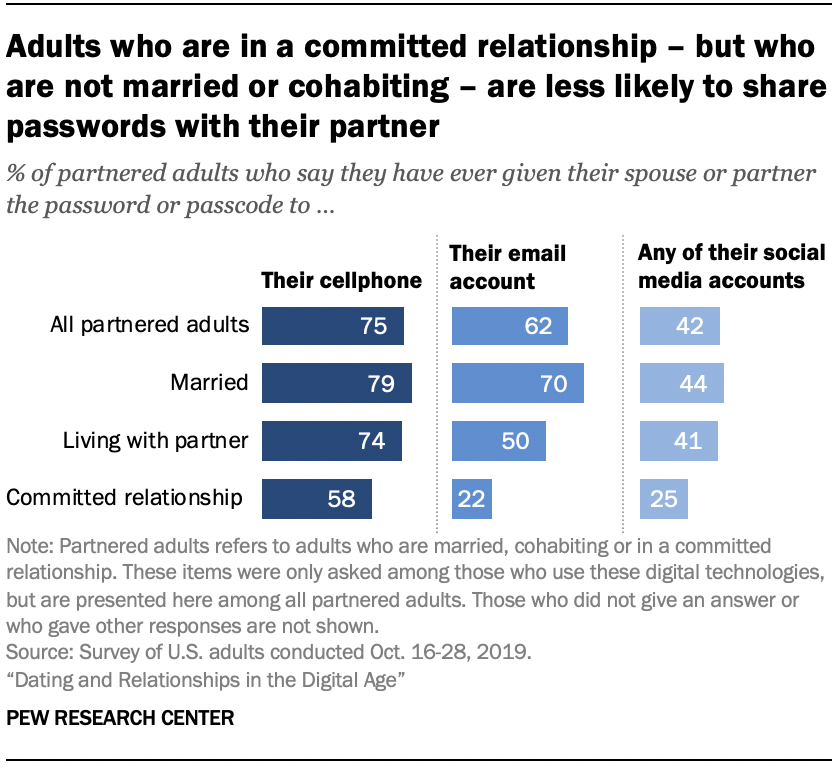 All the same, experiences do vary depending on the blazon of relationship partnered people have. Married or cohabiting adults are much more probable to share their cellphone or social media passwords with their partner than those who are in a committed relationship but are not living with their partner. Roughly iii-quarters or more of married adults (79%) or those who live with a partner (74%) say they take given their partner the password to their cellphone, compared with 58% of those who are in a committed relationship. A similar blueprint is present among partnered social media users when they are asked about whether they have shared their login data for any of their social media accounts. When it comes to email countersign sharing, married adults are the virtually probable grouping to say they have given their email password to their partner: lxx% say this, compared with 50% of cohabiting internet users and simply 22% of those in a committed relationship.
All the same, experiences do vary depending on the blazon of relationship partnered people have. Married or cohabiting adults are much more probable to share their cellphone or social media passwords with their partner than those who are in a committed relationship but are not living with their partner. Roughly iii-quarters or more of married adults (79%) or those who live with a partner (74%) say they take given their partner the password to their cellphone, compared with 58% of those who are in a committed relationship. A similar blueprint is present among partnered social media users when they are asked about whether they have shared their login data for any of their social media accounts. When it comes to email countersign sharing, married adults are the virtually probable grouping to say they have given their email password to their partner: lxx% say this, compared with 50% of cohabiting internet users and simply 22% of those in a committed relationship.
There also are some differences by age. Amid partnered adults, those ages eighteen to 49 are more than likely than those ages 50 and older to say they accept given their cellphone password to their spouse or partner (81% vs. 69%). On the other hand, older adults are more than likely than younger adults to say they have shared their email countersign with their pregnant other (70% vs. 59%).
Near social media users come across other people post nearly their relationship or dating life, but relatively few say these posts affect how they experience about their own human relationship
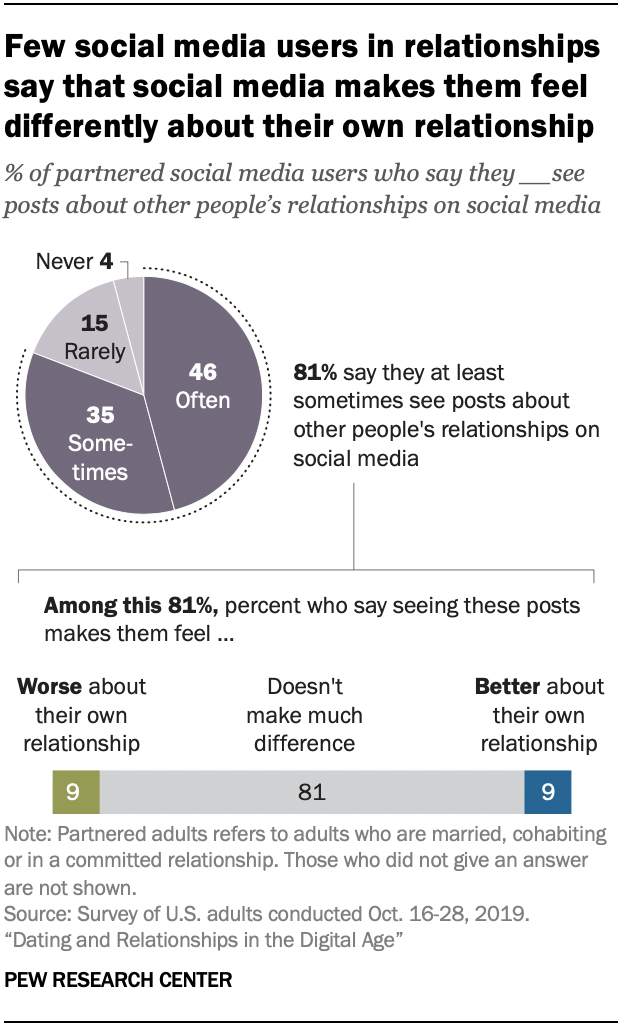 This survey conducted last fall also examined how social media might exist affecting the way people think well-nigh their own love lives. More than specifically, does seeing relationship posts on social media affect the mode people think about their own relationships?
This survey conducted last fall also examined how social media might exist affecting the way people think well-nigh their own love lives. More than specifically, does seeing relationship posts on social media affect the mode people think about their own relationships?
Overall, 8-in-ten social media users see others mail about their relationship on social media often or sometimes. This differs by both age and gender. Women are slightly more likely than men to see these posts (84% vs. 77%). In addition, ninety% of social media users ages 18 to 49 say they see these types of post at least sometimes, compared with 68% of those ages l and older.
A majority of social media users who are in a relationship (81%) say they see posts virtually other people's relationships when using social media. Among these partnered social media users, 78% of those who are married say they at to the lowest degree sometimes see posts about other people's relationships, compared with 89% of those who are living with partner and 86% of those in a committed human relationship.
Overall, seeing these posts appears to take little effect on how people view their ain romantic relationships. A large majority of partnered adults (81%) who at least sometimes see posts near other people's relationships say that these posts have not fabricated much of departure in how they feel about their own human relationship. On the other paw, relatively few say these posts make them feel better (9%) or worse (9%) about their human relationship.
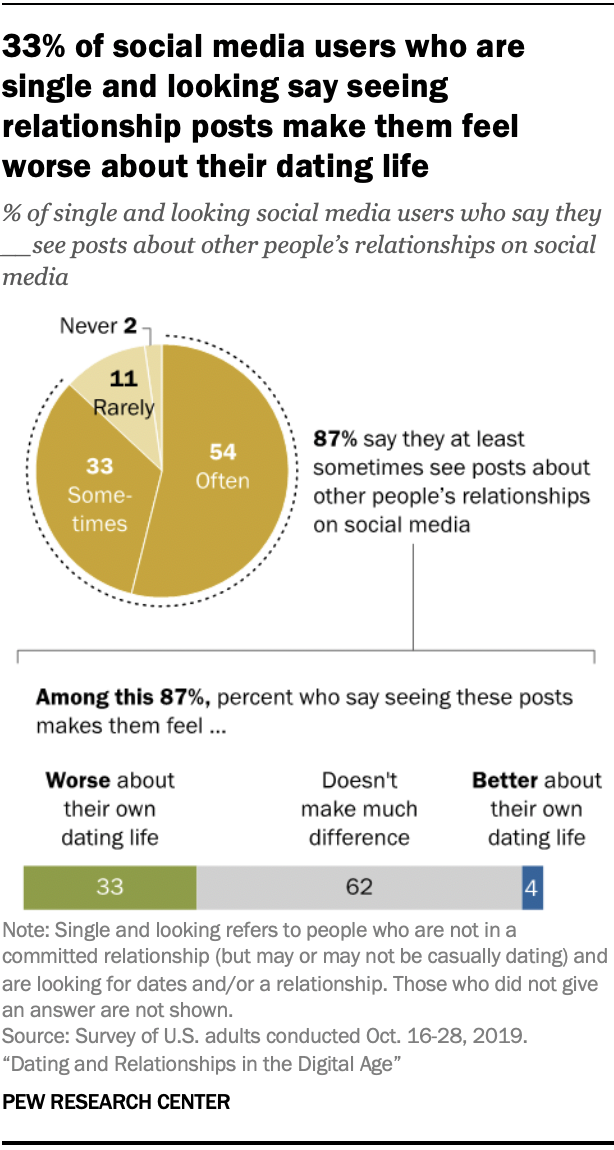 When information technology comes to social media users who are single and looking, 87% encounter other people making posts near their relationships on social media platforms at to the lowest degree sometimes. Social media users who are single and non looking for a human relationship or dates are less likely to report seeing these types of posts at least sometimes (78%).
When information technology comes to social media users who are single and looking, 87% encounter other people making posts near their relationships on social media platforms at to the lowest degree sometimes. Social media users who are single and non looking for a human relationship or dates are less likely to report seeing these types of posts at least sometimes (78%).
A 3rd of the social media users who are single and looking and who say they see others' posts about their honey life say that seeing these posts makes them feel worse. This compares with 62% who written report that such posts by others do not make much of a difference in how they feel about their ain dating life. But 4% say it makes them feel better.
These relationship-focused posts tend to have a bigger impact on women than men. Among social media users who are single and looking, women who meet relationships posts at least sometimes are more probable to report that seeing these posts on social media makes them feel worse about their dating lives than are their male counterparts (forty% vs. 28%).
Virtually 3-in-10 social media users say they have discussed their beloved life on social media
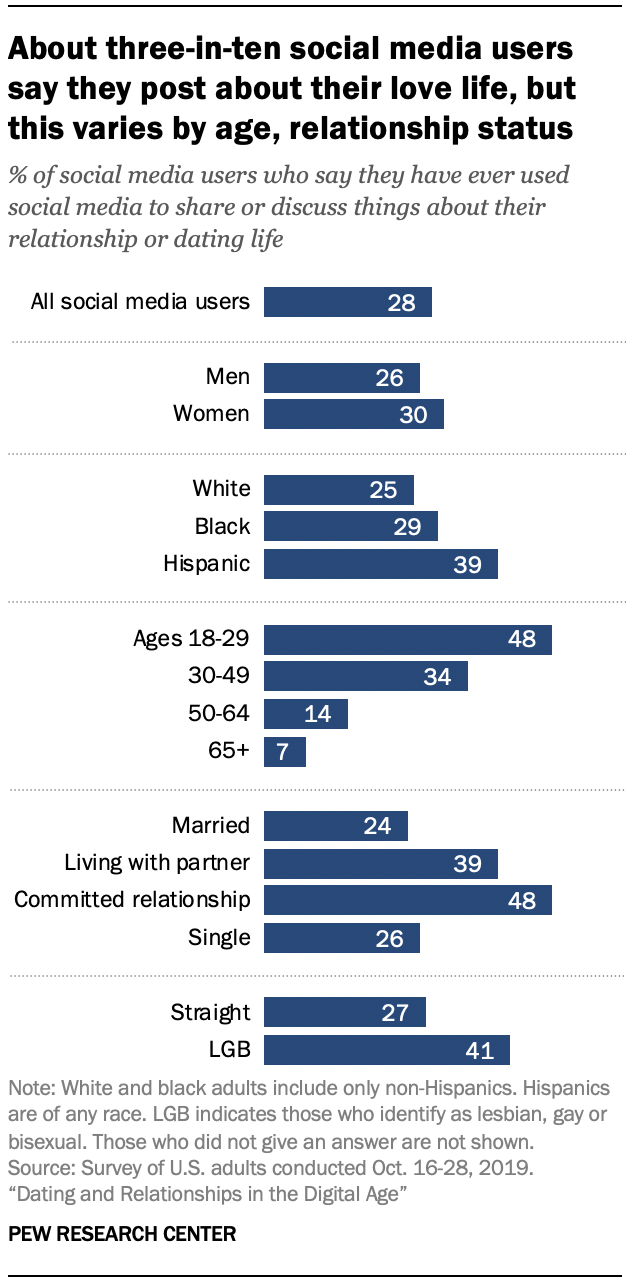 While it is fairly common for social media users to run into other people posting things about their love lives, only a minority of Americans who apply these platforms (28%) say they have ever shared or discussed things about their relationship or dating life. Almost 4-in-ten adults who are living with their partner (39%) and nigh half of those in a committed relationship (48%) just not living together say they have always posted near their human relationship on social media. Conversely, married and single adults are the to the lowest degree likely to post nearly their love lives (24% and 26%, respectively).
While it is fairly common for social media users to run into other people posting things about their love lives, only a minority of Americans who apply these platforms (28%) say they have ever shared or discussed things about their relationship or dating life. Almost 4-in-ten adults who are living with their partner (39%) and nigh half of those in a committed relationship (48%) just not living together say they have always posted near their human relationship on social media. Conversely, married and single adults are the to the lowest degree likely to post nearly their love lives (24% and 26%, respectively).
About iv-in-ten social media users who are either Hispanic or lesbian, gay or bisexual (LGB) say they take ever posted virtually their dating life or relationship on social media, while around 1-quarter of white, black and directly social media users say the aforementioned.
Younger social media users as well are more likely to have posted virtually their love lives on social media previously. While near half of social media users ages xviii to 29 have e'er posted on social media almost their dating life or relationship, a third of xxx- to 49-twelvemonth-olds say the aforementioned. By comparison, far fewer social media users ages fifty and older (11%) say they ever postal service near their relationship or dating life.
Roughly half of social media users have used these sites to check upwardly on an ex-romantic partner
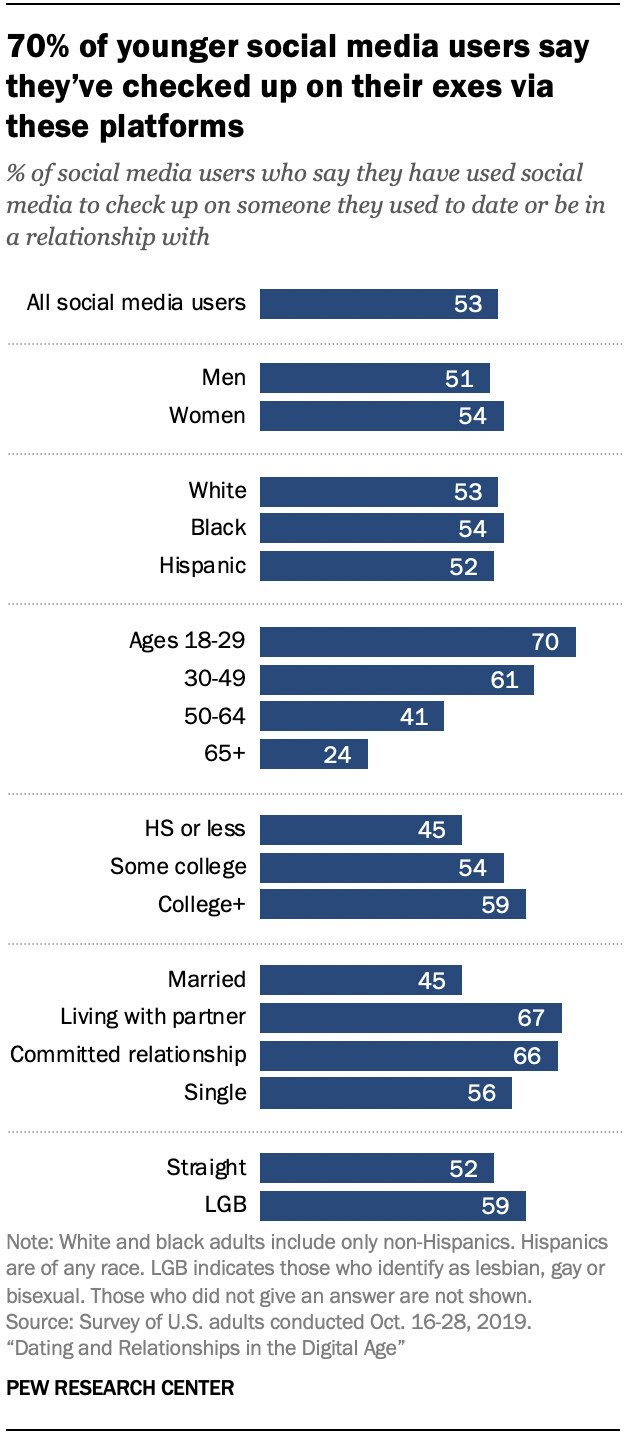 Using social media to check upwards on former romantic partners is a fairly mutual do amidst social media users. Well-nigh half of social media users (53%) say they have used these sites to check up on someone with whom they were in a relationship or whom they used to date.
Using social media to check upwards on former romantic partners is a fairly mutual do amidst social media users. Well-nigh half of social media users (53%) say they have used these sites to check up on someone with whom they were in a relationship or whom they used to date.
Social media users ages eighteen to 49 are far more likely than those ages 50 and older to study using social media to bank check up on an ex-romantic partner. 7-in-ten eighteen- to 29-twelvemonth-olds written report that they accept used these platforms to cheque up on someone they used to date or be in a relationship with. That share is lower – though still a majority – among users ages xxx to 49 and falls sharply amid those ages and 50 and older.
There also are some notable differences, depending on a person'due south human relationship condition. Well-nigh two-thirds each of social media users who are cohabiting or in a committed human relationship say they accept used social media to cheque upward on someone they used to date. Meanwhile, 56% of single people, and fifty-fifty fewer married people (45%), say the aforementioned. In addition, social media users who have a high school degree or less education are less likely to report that they have used to social media to check up on an ex-romantic partner than those with a bachelor's or advanced caste or who accept some higher feel.
Younger Americans in relationships are specially likely to view social media every bit having an of import part in connecting and keeping up with their partner
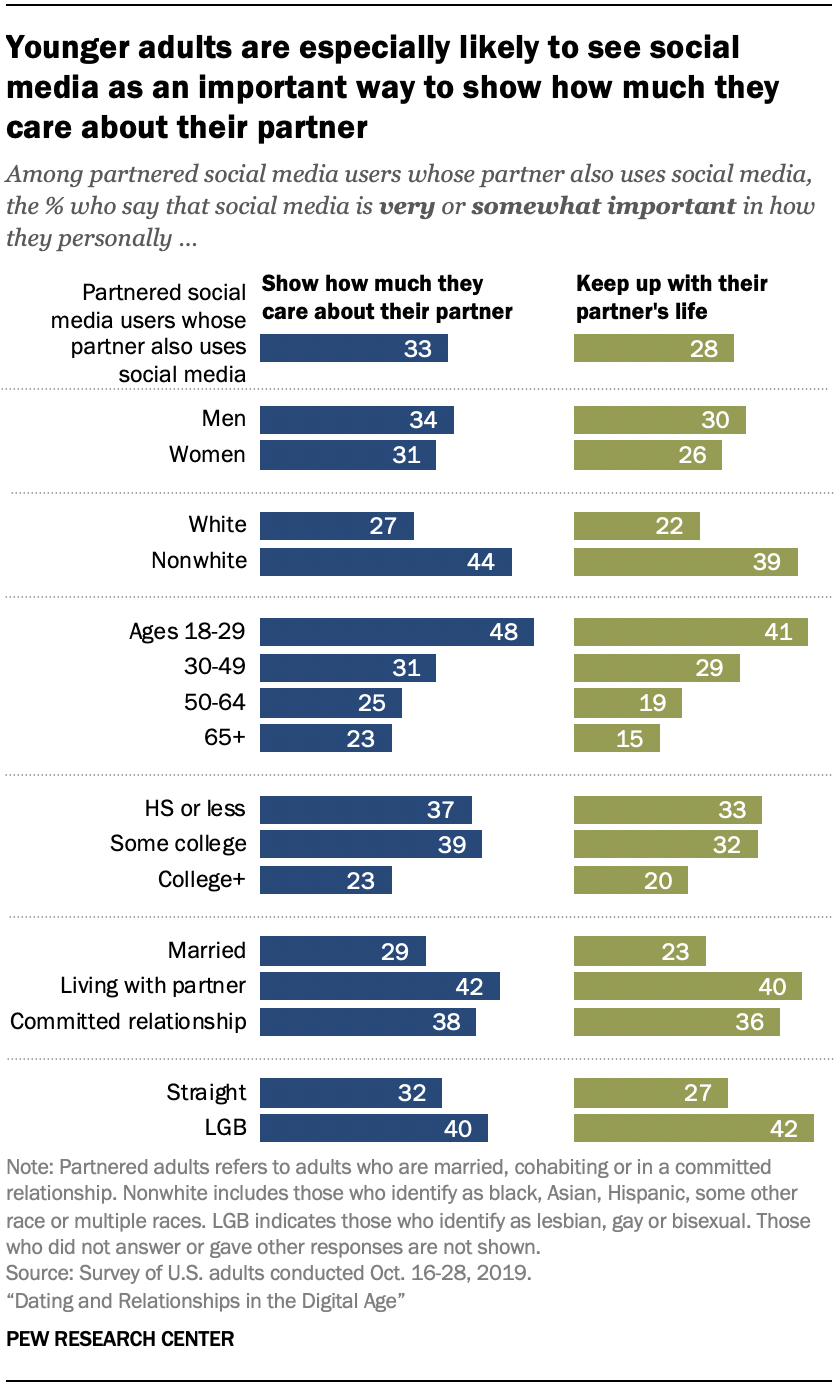 Overall, most iii-in-ten partnered adults who use social media say that these sites are at to the lowest degree somewhat important in showing how much they care nigh their partner (33%) or keeping upwards with what is going on in their partner'due south life (28%). But the level of importance that these users place on social media varies essentially past age. Among partnered social media users, 48% of 18- to 29-twelvemonth-olds say these platforms are very or somewhat of import in how they bear witness how much they care well-nigh their partner, compared with 28% of those ages 30 and older who say this.
Overall, most iii-in-ten partnered adults who use social media say that these sites are at to the lowest degree somewhat important in showing how much they care nigh their partner (33%) or keeping upwards with what is going on in their partner'due south life (28%). But the level of importance that these users place on social media varies essentially past age. Among partnered social media users, 48% of 18- to 29-twelvemonth-olds say these platforms are very or somewhat of import in how they bear witness how much they care well-nigh their partner, compared with 28% of those ages 30 and older who say this.
At that place as well are historic period differences when it comes to the importance social media users identify on these platforms for keeping up with their significant other'south life. About four-in-ten partnered users ages 18 to 29 say social media is somewhat or very important when it comes to keeping upward with what's going on in their partner'southward life, compared with 29% of those ages 30 to 49 and but 17% of those ages 50 and older.
Married social media users are more probable than those who are cohabiting or in a committed relationship to say they do not see social media as important for keeping up with what's going on in their partner'south life or for showing how much they care near their partner.
The level of importance that partnered adults identify on social media also varies by race and ethnicity too every bit by sexual orientation. Nonwhite social media users are more than probable than white users to say these platforms are a very or somewhat of import for keeping upward with their partner'due south life and showing how much they care.4 Among partnered social media users, LGB adults are more likely than those who are straight to say social media is at least somewhat important for keeping up with their partner'due south life or showing how much they care.
Even when controlling for age, racial and ethnic differences persist when it comes to the likelihood of saying social media is a personally important way to keep up with one's partner or prove how much they care. Similarly, marital status and sexual orientation are meaning predictors of how important it is for people to employ social media to go along up with one's partner, even after controlling for age differences.
Social media can exist a source of jealousy and uncertainty in relationships – particularly for younger adults
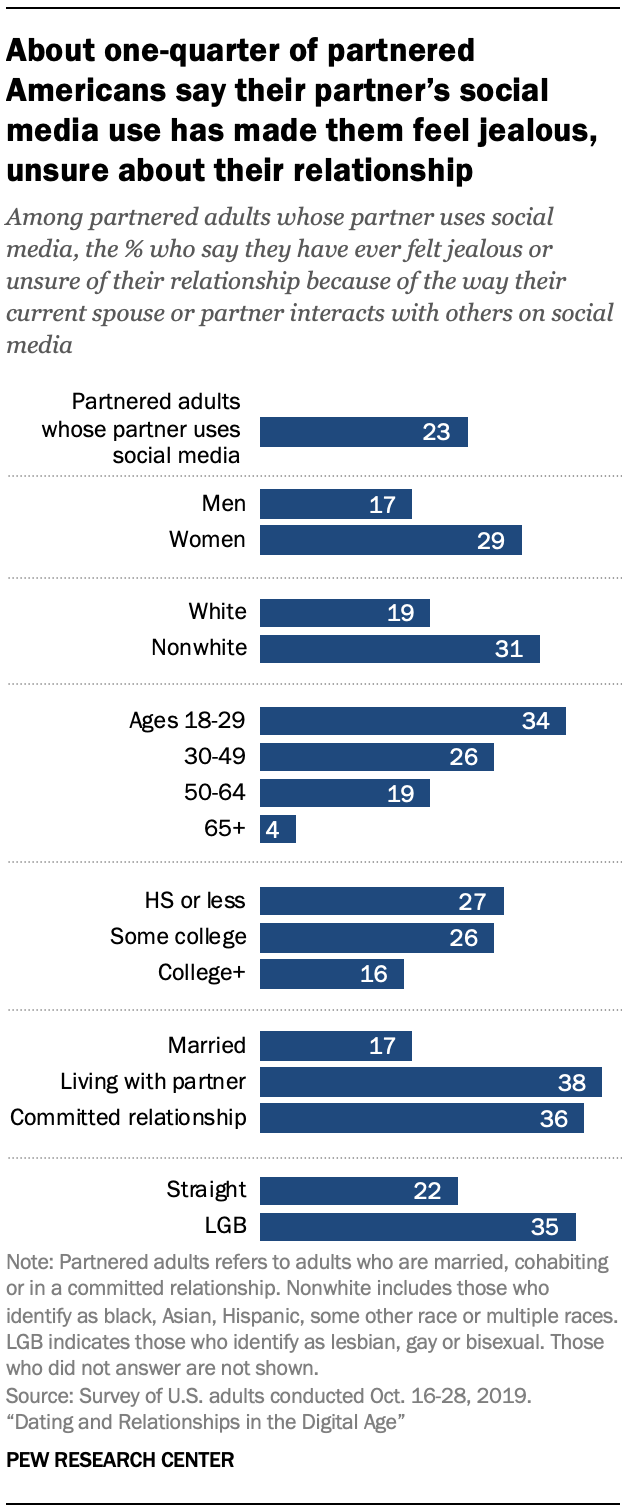 Even as younger Americans value social media as a place to share how much they care about their partner or to keep up with what'south going on in their partner'due south life, they also acknowledge some of the downsides that these sites tin can have on relationships.
Even as younger Americans value social media as a place to share how much they care about their partner or to keep up with what'south going on in their partner'due south life, they also acknowledge some of the downsides that these sites tin can have on relationships.
Overall, 23% of partnered adults whose meaning other uses social media say they have felt jealous or unsure about their human relationship considering of the style their current spouse or partner interacts with other people on social media. But this share is even higher among those in younger historic period groups.
Among partnered adults whose pregnant other uses social media, 34% of 18- to 29-year-olds and 26% of those ages 30 to 49 say they accept felt jealous or unsure in their current relationship because of how their partner interacted with others on social media, compared with 19% of those ages 50 to 64 who say this and iv% of those ages 65 and up. Nearly four-in-10 unmarried adults with partners who are social media users (37%) say they have felt this way well-nigh their current partner, while but 17% of married people say the same.
Women as well are more probable to limited displeasure with how their significant other interacts with others on social media. Women who say their partner uses social media are more likely than men to say they have felt jealous or unsure of their relationships because of how their partner interacts with others on social media (29% vs. 17%).
Among those whose partner uses social media, about iii-in-ten nonwhite adults who are in a relationship report having felt jealous or uncertain in their current relationship based on their partner'south social media interactions, compared with nineteen% of white adults who say the same. About ane-third of LGB partnered adults whose significant other uses social media report that they accept felt jealous or unsure in their current relationship because of how their partner interacted with others on social media, while 22% of directly people say this. Higher graduates are less probable to written report having felt this way than those with some college experience or a high school degree or less.
Source: https://www.pewresearch.org/internet/2020/05/08/dating-and-relationships-in-the-digital-age/
0 Response to "Peer Reviewed Articles on Dating in the Digital Age"
Post a Comment